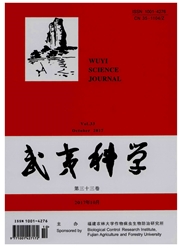

 中文摘要:
中文摘要:
Plantations of eucalypts as short-rotation tree crops are rapidly expanding in tropical and sub-tropical regions, including southern China, where the soils are acidic and available phosphorus(P) is limited. We investigated seedling growth, dry matter accumulation, and the dynamics of photosynthetic rate and chlorophyll content of seven Eucalyptus species/hybrids(E. dunnii, E. grandis, E. grandis × E. camaldulensis, E. urophylla × E. camaldulensis, E. urophylla × E. tereticornis, E. grandis × E. tereticornis, E. urophylla × E. grandis) in response to different levels of P supply(0, 6, 12 and 18 mg?kg-1 KH2PO4). The photosynthetic rate and the chlorophyll content significantly declined as the P supply declined in almost a linear fashion for all species as the P stress period extended. In the absence of P supply, height growth of seedlings of all species was significantly impaired, while root collar diameter growth and whole plant dry matter accumulation was not affected by the level of P supply in most of the species. Significant inter-species variations in growth, dry matter accumulation and photosynthetic rate in response to P supply were detected. Eucalyptus dunnii had the lowest growth performance across all levels of P supply while E. urophylla × E. tereticornis showed superior growth performance. From a practical point of view, E. urophylla × E. tereticornis is suggested as a candidate hybrid for planting on slightly P-deficient sites in southern China while E. dunnii, being a slow-growing species, is not suitable for short-rotation plantation. On plantation sites where severe P deficiency exists, P fertilization needs to be considered to boost rapid growth of seedlings so as to meet the management objectives of short-rotation plantation.
 英文摘要:
英文摘要:
Plantations of eucalypts as short-rotation tree crops are rapidly expanding in tropical and sub-tropical regions, including southern China, where the soils are acidic and available phosphorus (P) is limited. We investigated seedling growth, dry matter accumulation, and the dynamics of photosynthetic rate and chlorophyll content of seven Eucalyptus spe- cies/hybrids (E. dunnii, E. grandis, E. grandis x E. camaldulensis, E. urophylla x E. camaldulensis, E. urophylla x E. tereticornis, E. grandis x E. tereticornis, E. urophylla x E. grandis) in response to different levels of P supply (0, 6, 12 and 18 mg-kg-l KH2PO4). The photosynthetic rate and the chlorophyll content significantly declined as the P supply declined in almost a linear fashion for all species as the P stress period extended. In the absence of P supply, height growth of seedlings of all species was significantly impaired, while root collar diameter growth and whole plant dry matter accumulation was not affected by the level of P supply in most of the species. Significant inter-species variations in growth, dry matter accumulation and photosynthetic rate in response to P supply were detected. Eucalyptus dunnii had the lowest growth perform- ance across all levels of P supply while E. urophylla x E. tereticornis showed superior growth performance. From a practical point of view, E. urophylla x E. tereticornis is suggested as a candidate hybrid for planting on slightly P-deficient sites in southern China while E. dunnii, being a slow-growing species, is not suitable for short-rotation plantation. On plantation sites where severe P deficiency exists, P fertilization needs to be considered to boost rapid growth of seedlings so as to meet the man- agement objectives of short-rotation plantation.
 同期刊论文项目
同期刊论文项目
 同项目期刊论文
同项目期刊论文
 Litterfall production and nutrient return in different-aged Chinese fir (Cunninghamia lanceolata) pl
Litterfall production and nutrient return in different-aged Chinese fir (Cunninghamia lanceolata) pl 期刊信息
期刊信息
